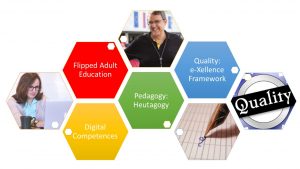A framework is a particular set of rules, ideas, or beliefs which you use in order to deal with problems or to decide what to do[1].

Pattern of the framework developed in the FADE-in project
Typical problems in education are quality enhancement, needs and preconditions of learners, pedagogical concepts, structure of lessons (or courses) and others. Teaching and learning frameworks are research-informed models for course design that help instructors align learning goals with classroom activities, create motivating and inclusive environments, and integrate assessments into learning.
For trainers and educators´ frameworks are a help for their teaching. The combination of scientifically researched knowledge and the empirical (or practical) experience of trainers pioneering new approaches to training are a great impact to the teaching community.
The FADE-in project compiles exactly these two items to create a modern multimedia-based guide to “Flipped Adult Education”.
Frameworks used in the FADE-in Project:
- The European quality benchmark for online, open and flexible education e-xcellence
This framework was created for universities, nevertheless it can be adapted for the creation of flipped adult education courses - The DigiComp framework for citizens
This framework was developed by the JRC (Joint Research Center) of the European Commission.
[1] Colins English Dictionary
